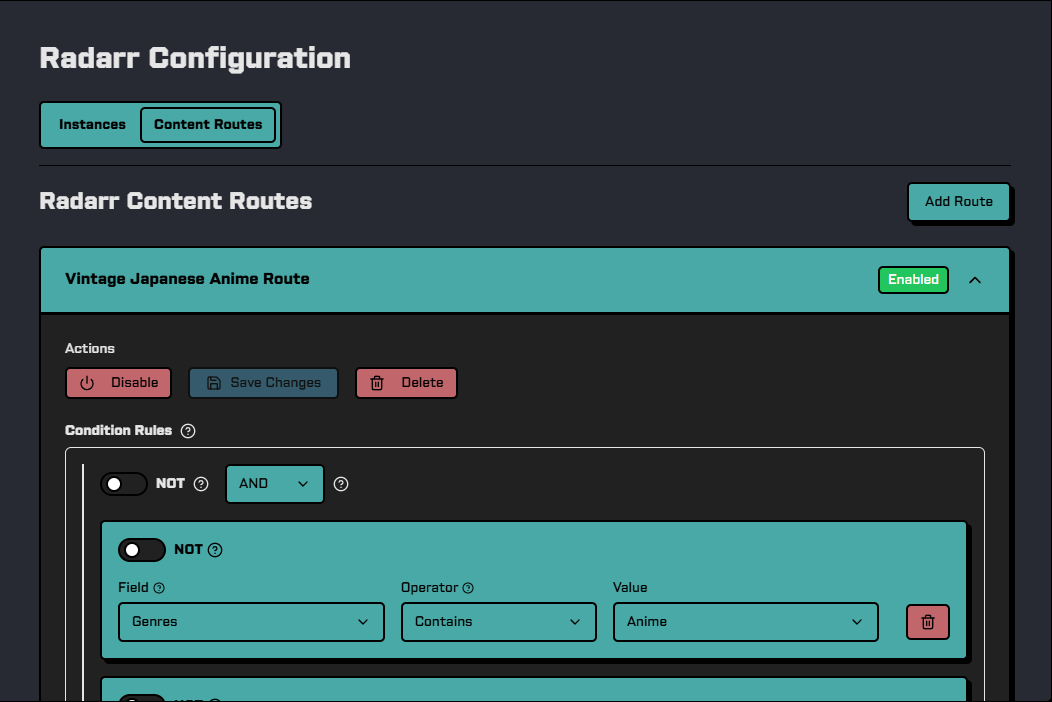Advanced Content Routing
Intelligently direct content to the appropriate Sonarr/Radarr instances using powerful predicate-based routing rules.
If you're upgrading from a version prior to 0.2.15, you may need to delete and recreate your content routes if you experience routing issues.


Quick Setup
- Navigate to Content Router in the Pulsarr interface
- Click Add Rule to create your first routing rule
- Configure conditions (e.g., "IF genre contains 'Anime'")
- Select target instance and configure overrides (quality profile, root folder)
- Set priority (higher numbers = higher priority)
- Save and test by adding content that matches your rule
Key Features
Conditional Logic: Complex decision trees with AND/OR operators, nested condition groups, and priority-based processing.
Routing Criteria: Route content based on genre, user, language, year, certification, or season count.
Multi-Instance Support: Send content to multiple instances simultaneously with different configurations.
Automatic Anime Detection
Pulsarr automatically detects anime content to enable targeted routing and processing. When content is processed through the Content Router, it checks external IDs (TVDB, TMDB, IMDb) against a comprehensive anime database.
How it works:
- Downloads anime database from the anime-lists repository
- Updates automatically every Sunday at 3 AM
- Matches content IDs against anime database entries
- Automatically adds "anime" to content genres when matched
- Enables anime-specific routing rules (e.g.,
genre contains "Anime")
Database Sources:
- Primary: anime-list-full.xml from anime-lists GitHub repository
- Supported IDs: TVDB, TMDB, IMDb external identifiers
- Update Schedule: Weekly automatic updates (Sundays at 3 AM)
This seamless detection allows you to create routing rules like IF genre contains "Anime" without manually tagging content, as the system automatically identifies and classifies anime for you.
Creating Rules
Each rule consists of:
- Conditions: Genre contains "Anime", User equals "KidsAccount", etc.
- Target Instance: Which Sonarr/Radarr instance receives the content
- Instance Settings: Quality profile, root folder, monitoring options
- Priority: Higher priority rules take precedence
Instance Configuration Overrides
When creating routing rules, you can override these instance settings:
Sonarr Overrides
Core Settings:
- Quality Profile: Override default quality profile
- Root Folder: Route to specific folder path
- Tags: Apply specific tags for organization
- Search on Add: Automatically search when added
Series Settings:
- Series Type: Override series type (
standard,anime,daily) - Season Monitoring: Override monitoring strategy:
all- All Seasonsfuture- Future Seasonsmissing- Missing Episodesexisting- Existing EpisodesfirstSeason- First SeasonlastSeason- Last SeasonlatestSeason- Latest Seasonpilot- Pilot OnlypilotRolling- Pilot Rolling (Auto-expand, requires session monitoring)firstSeasonRolling- First Season Rolling (Auto-expand, requires session monitoring)recent- Recent EpisodesmonitorSpecials- Monitor SpecialsunmonitorSpecials- Unmonitor Specialsnone- Noneskip- Skip
Radarr Overrides
Core Settings:
- Quality Profile: Override default quality profile
- Root Folder: Route to specific folder path
- Tags: Apply specific tags for organization
- Search on Add: Automatically search when added
Routing Conditions
Available Fields:
- Genres: Content genre categories
- User: User ID or username
- Year: Release year
- Certification: Content rating (PG-13, R, TV-MA, etc.)
- Original Language: Original language of content
- Season: Season number (Sonarr only)
Multi-Instance Routing
Multiple Instance Support: Content router rules can send the same content to multiple instances simultaneously. For example:
- Anime Rule 1 → Anime-Sonarr-HD (priority 100)
- Anime Rule 2 → Anime-Sonarr-4K (priority 90)
- Both rules fire for anime content, sending it to both instances with their respective configurations
Priority Evaluation: Priorities only matter when multiple rules target the same instance - highest priority rule wins and applies its settings (quality profile, root folder, etc.).
For comprehensive multi-instance synchronization and distribution features, see Multi-Instance Support.
Rule Processing
When content is added to a watchlist:
- All routing rules are evaluated in priority order
- Content is sent to all matching instances (multiple instances supported)
- For multiple rules targeting the same instance, highest priority wins
Example Rules
Anime Routing:
IF genre contains "Anime"
THEN route to "Anime-Sonarr" with "HD-1080p" profile
User-based Routing:
IF user equals "KidsAccount"
THEN route to "Family-Sonarr" with "Family" profile in "/kids" folder
Year-based Routing:
IF year is less than 2000
THEN route to "Classics-Radarr" with "Archive" profile
Best Practices
- Use higher priorities (90-100) for specific rules
- Start with simple rules before adding complexity
- Review logs if content isn't routing as expected
- Test rules with dry runs before applying to production
- Document your routing strategy for team collaboration
Troubleshooting
Rules not matching content:
- Verify the condition field matches available metadata (check TMDB/TVDB data)
- Review genre spelling and casing (case-sensitive matching)
- Check that content has the required metadata fields populated
- Use logs to see which rules are evaluated and why they fail
Content routing to wrong instance:
- Review rule priorities - highest priority wins for same instance
- Check for overlapping rules targeting different instances
- Verify target instance is configured and online
- Confirm quality profiles and root folders exist on target instance
Multiple instances receiving same content unexpectedly:
- This is expected behavior if multiple rules match and target different instances
- Review all matching rules and their target instances
- Use priority to control which settings apply when multiple rules target same instance
Anime not being detected:
- Verify anime database has been downloaded (first run may take time)
- Check that content has external IDs (TVDB, TMDB, IMDb)
- Review logs for anime detection results
- Wait for weekly update if content is new (Sundays at 3 AM)
Router overrides not applying:
- Confirm the rule is actually matching (check logs)
- Verify override values are valid for the target instance
- Check that router rule has higher priority than conflicting rules
- Ensure target instance supports the configured overrides
API Reference
See the Content Router API documentation for managing routing rules programmatically.